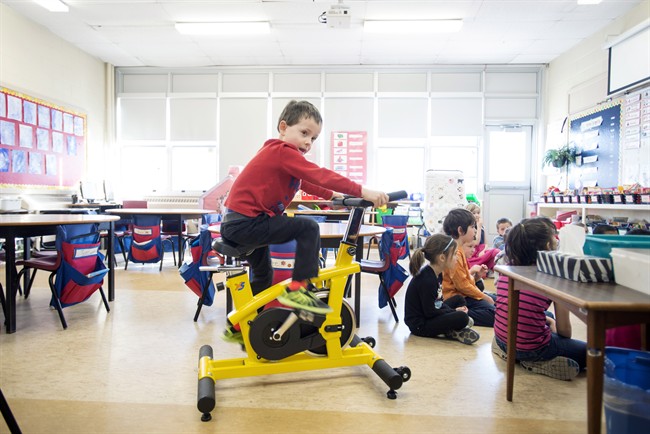Frustrated at her inability to draw a sofa, five-year-old Mylee Lumsden began to cry.

She liked her drawing of a TV, but the couch confounded her, and so she grew increasingly upset.
Her teacher, Mary Theresa Burt, looked at the brewing storm, and suggested the little girl take a turn on the bright yellow stationary bicycle at the centre of her primary classroom at Ian Forsyth Elementary School.
READ MORE: New shipment of stationary bikes arrives for Halifax-area schools
Mylee started pedalling, her shoulder-length hair bouncing in time. Within minutes, it was as if a switch had been flicked – she was bright again, cheerful, and smiling widely.
“I go on the bike when I’m feeling a little bit sad,” Lumsden cooed, her little legs rapidly pedalling. “It makes me feel happy.”
The tiny yellow bike is a symbol of a growing revolution in Canadian classrooms – and beyond. Students used to be taught to stay quiet and stay still, and those who couldn’t – boys, especially – often found themselves in trouble.
WATCH: An initiative to put stationary bikes in classrooms is taking off in Southeastern New Brunswick, with several schools joining in.
Now, amid a shift in how educators understand and embrace various styles of learning, such bikes are helping to boost moods, relieve stress and regulate energy in students of all ages.
Students cycle when restless, stressed, sad
Luke MacDonald – a local fitness club owner who led the charge to bring the silent, stationary exercise bikes into Halifax-area classrooms roughly three years ago – said children are taught to hop on the bike whenever they’re feeling restless, tired, stressed, sad or essentially whenever they feel like it.
“And they don’t stop learning during that time. In fact, when they’re on the bike, they generally pay more attention,” said MacDonald, who previously ran a running club for kids, and has now helped place more than 1,300 bikes in classrooms across Canada and beyond.
“When that kid transfers that information home, and they run on the spot or they do jumping jacks when they start feeling stressed, that’s self-regulation. And that can change the trajectory of a five-year-old kid for the rest of their life.”
According to many accounts, the bicycles-in-the-classroom movement began in 2009, with a Eureka moment from a guidance counsellor at a school in Winston-Salem, N.C. That Read and Ride program – many of the bikes have attached desktops – now has programs in 30 states, and imitators worldwide.
MacDonald said he helped develop the classroom spin bike initiative with the Ontario-based non-profit organization Run for Life after hearing a lecture by Stuart Shanker about self-regulation.
Shifting how children handle stress
Shanker, a professor at York University in Toronto, said self-regulation is the energy we burn to deal with stress and how well we recover from that expenditure.
Shanker said research shows that deep breathing, like the kind that happens on a stationary bike, triggers a shift in how children handle stress and how they recover from it.
“The stationary bikes have a profound self-regulating effect for a great many children, but especially those children that are very restless and those that have problems with sustained attention and heightened impulsivity,” said Shanker in a recent phone interview.
“What we have found is that the children very quickly learn when they need to get on the bike and how much time they need on the bike. It’s really quite transformative.”
Exercise equipment has been in classrooms at James S. Bell Junior Middle Sports and Wellness Academy in the Toronto suburb of Etobicoke for about eight years. Principal John Currie said the school first started using bikes and treadmills in a special education class.
“We had a group of students who had struggled throughout their academic career. They were disengaged and academics and behaviour were an issue,” said Currie.
“Over the course of that year, we found significant improvement in their academic achievement, particularly in language and mathematics. We had a group of eight students in there and as a whole, they went up two plus grade levels.”
The school now has about 25 spinning bikes in seven classrooms (Grades 6-8) and in the library, said Currie.
“When I go into classrooms, I never see the bikes not being used,” he said. “We find that by being active, students are more engaged in the lesson and more engaged in general.”
In Nicole LeGrow’s Grade 2/3 classroom at Ian Forsyth Elementary, children are taught to jump on the bike whenever they want. The teacher said her students all use it regularly.
“It’s amazing. The kids love it and it really does help them focus,” said Legrow.
- Trudeau tight-lipped on potential U.S. TikTok ban as key bill passes
- Canadian man dies during Texas Ironman event. His widow wants answers as to why
- Hundreds mourn 16-year-old Halifax homicide victim: ‘The youth are feeling it’
- On the ‘frontline’: Toronto-area residents hiring security firms to fight auto theft



Comments